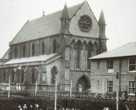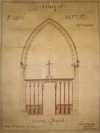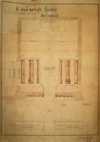 Nottingham Nottingham
St John the Baptist
Features and Fittings
Font
Plain stone with a conical shaped wooden cover suspended and balanced. Position unknown. In situ 1937. Given in memory of the Rev Charles Yeld who died 1874.
A pre-construction drawing by the architects, Scott and Moffatt shows an ornate squared-top font resting on a central pillar surrounded by four shafts. It was located at the west end of the central aisle.
Pulpit
A bracketed stone pulpit set on angle across the corner formed by the east wall of the nave and the north wall of the chancel. The priest entered the pulpit through a small door at the rear, which led from a few steps within the chancel, effectively he disappeared from the view behind the chancel arch and re-appeared in the pulpit.
Lectern
Brass eagle, located on the north side the nave in front of the chancel screen.
Altar
Oak with pierced decoration which was adorned with six large brass candlesticks
Sanctuary
Two oak benches and a carved oak credence table with two candlesticks. The sanctuary also housed an Epiphany Madonna, a black wood cross with plated figure, a brass incense burner and spoon plus seventeen brass candlesticks and a brass book-rest.
The church had a good selection of silver mainly presented as memorials by the relatives of former members of the congregation. It included a chalice, a paten, a flagon and an alms dish — with a total weight of over eighty ounces.
Nine paintings were hung on the chancel walls
Reading desk
An oak reading desk for the clergy was located in front of the chancel arch on the south side of the nave
 Architect’s drawing Architect’s drawing
of the screen
in the chancel arch |
Chancel Screen
An original architect’s drawing in the Nottinghamshire Archives shows a chancel screen set under the chancel arch. The drawing is not dated and the signature is not clear. It appears to be Dutton Walker of Nottingham. Walker (1833-1855) could not have been involved in the original building work, so it is probable that this was a proposed addition at some later date, some refurbishment was done about 1858-1862.
The screen shown has four, lancet-headed panels raising from the floor on each side forming the central entrance. Four slender spines then rise to carry the pediment of the screen on carved capitals. A central crucifix completes the structure the arms in line with the capitals of the chancel arch.
 Architect’s plan Architect’s plan
of the chancel
showing stalls
(and front pews) |
Seating
All the pews in the nave and the choir were made from pitch pine There were twenty-eight pews on each side of the central aisle, with side aisles between the pew ends and the external walls of the nave.
In the chancel were two short rows of pews. The choir had originally been located at the western end of the church with the seating in the chancel (possible rented) and reserved for the ‘fashionables’.
Lighting
The original lighting was by oil lamps, then gas and finally sometime in the 1920s electricity.
Heating
Few houses in the parish would have enjoyed the luxury of heating. The church had an iron pipe heating system, so it must have been a much warmer place to be than most of the parishioners’ own unheated homes.
|